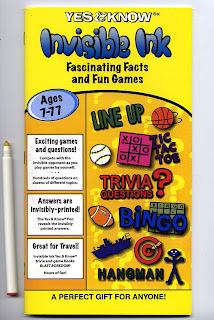Saturday, September 05, 2009
Skinner's Quiz Box
With Labor Day coming up, I've had to think about how to keep the kids occupied on some long trips -- which why I'm on NPR Weekend Edition today to talk about Yes & Know invisible ink books...

They still look and work the same today as when I was a kid, and I became intrigued: where did these books come from, anyway? I tracked them down to a 1974 patent by Leon Lenkoff of Louisville, Kentucky. (His company, Lee Publications, continues making Yes & Know to this day.) But what struck me was that he cited a 1968 patent by a "Burrhus Frederic Skinner."
B... F... Skinner?

Yep!
Skinner's invention was part of his interest in automating learning; a handwriting worksheet that turned red when drew outside the dotted lines would save teacher labor for more personalized tasks. It was Lenkoff's bright idea to take this idea of defined areas of invisible ink and apply them to tic-tac-toe, 20 Questions, and a Battleship knockoff called "Fleet."
Skinner himself notes an older patent by an Antioch College chemistry instructor for a self-correcting quiz (e.g. fill in the wrong bubble and it turns red, while the correct answer bubble turns green). Skinner was so fond of that idea that he patented an anti-cheating version.
It's a charmingly retro technology. But it turns out that cheatproof decoder pen idea is making a comeback in polling booths this year with a vote confirmation system called Scantegrity.

So all those games of Decoder Pen Baseball on the airplane and in the car? Training for secure voting...


They still look and work the same today as when I was a kid, and I became intrigued: where did these books come from, anyway? I tracked them down to a 1974 patent by Leon Lenkoff of Louisville, Kentucky. (His company, Lee Publications, continues making Yes & Know to this day.) But what struck me was that he cited a 1968 patent by a "Burrhus Frederic Skinner."
B... F... Skinner?

Yep!
Skinner's invention was part of his interest in automating learning; a handwriting worksheet that turned red when drew outside the dotted lines would save teacher labor for more personalized tasks. It was Lenkoff's bright idea to take this idea of defined areas of invisible ink and apply them to tic-tac-toe, 20 Questions, and a Battleship knockoff called "Fleet."
Skinner himself notes an older patent by an Antioch College chemistry instructor for a self-correcting quiz (e.g. fill in the wrong bubble and it turns red, while the correct answer bubble turns green). Skinner was so fond of that idea that he patented an anti-cheating version.
It's a charmingly retro technology. But it turns out that cheatproof decoder pen idea is making a comeback in polling booths this year with a vote confirmation system called Scantegrity.

So all those games of Decoder Pen Baseball on the airplane and in the car? Training for secure voting...
